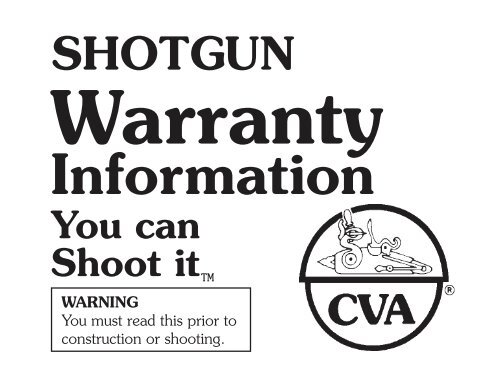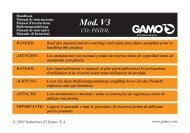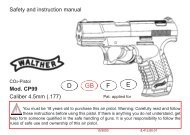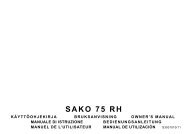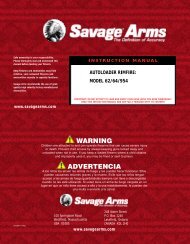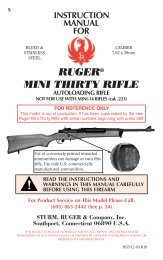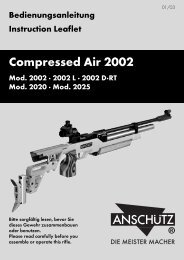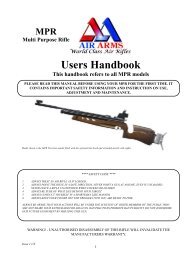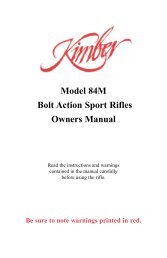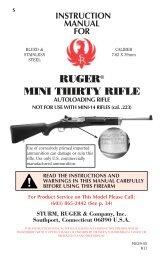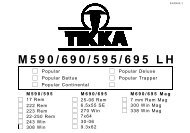CVA Trapper
CVA Trapper
CVA Trapper
Create successful ePaper yourself
Turn your PDF publications into a flip-book with our unique Google optimized e-Paper software.
SHOTGUN<br />
Warranty<br />
Information<br />
You can<br />
Shoot it <br />
WARNING<br />
You must read this prior to<br />
construction or shooting.
Muzzleloading Shotguns<br />
Replicas of original muzzleloading guns are as faithful to the original designs<br />
as possible. For this reason, replicas cannot be made with many of the<br />
refinements and features the shooter has come to expect as standard on<br />
modern cartridge firearms.<br />
Each shooter should remember that now, just as in colonial days, there is<br />
no way to build a shotgun to absolve the user of the need to use good judgment.<br />
When handled properly, a shotgun is a safe and enjoyable firearm to shoot.<br />
If abused, harmful consequences can result. Remember, this shotgun should<br />
be treated with the full respect due any firearm.<br />
You should know that the warranty applies only to parts of this product<br />
which have not been altered in any way. Therefore, it is important that you<br />
take the time to familiarize yourself with each part and its function prior to<br />
shooting.<br />
©Copyright, 1983 <strong>CVA</strong>
Table of Contents<br />
Page<br />
A Important Cautions .......................................................................... 2<br />
B Introduction ....................................................................................... 3<br />
C Blackpowder ...................................................................................... 4<br />
D Preparation Before Loading ............................................................. 6<br />
E Recommended Blackpowder Charges .............................................. 8<br />
F Shot .................................................................................................. 10<br />
G Buckshot .......................................................................................... 11<br />
H Single Projectile .............................................................................. 13<br />
I Buffering Components .................................................................... 13<br />
J Wads ................................................................................................ 14<br />
K Loading and Shooting of Percussion Shotgun ............................... 18<br />
L Cleaning and Maintenance ............................................................ 28<br />
M Ten Commandments of Muzzleloading .......................................... 29<br />
N Ordering Instructions ..................................................................... 30<br />
O Limited One Year Product Warranty ............................................. 31<br />
P Statement of Liability ..................................................................... 32<br />
Q Service - (770) 449-4687.................................................................. 33
A. IMPORTANT CAUTIONS<br />
1. Always wear shatter proof shooting glasses and ear protection.<br />
2. Use blackpowder only. (See page 4.)<br />
3. Never fire a muzzleloading shotgun unless wad (or ball) is firmly<br />
seated against powder charge.<br />
4. Do not exceed recommended maximum powder charges. (See page 9.)<br />
5. Never lean over (or stand in front of) muzzle at any time.<br />
6. Never attempt to shoot out a wad (or ball) which is not firmly seated<br />
against powder charge.<br />
7. Treat a misfire or failure to fire as though the gun can fire at any<br />
second. (See page 23.)<br />
8. Do not use any form of wadding except those recommended by <strong>CVA</strong>.<br />
(See page 14.)<br />
9. Handle a muzzleloading shotgun with the same respect due all<br />
firearms.<br />
10. Be sure all spectators and bystanders are completely behind you when<br />
firing. Flames and cap bits sometimes exit to the side of the gun.<br />
11. Never smoke while loading, shooting or handling black powder.<br />
12. If one barrel of the muzzleloading shotgun is fired, remove the percussion<br />
cap from the unfired barrel prior to reloading the fire barrel.<br />
2
B. INTRODUCTION<br />
1. This manual contains instructions, cautions and dangers for the safe use<br />
of <strong>CVA</strong> muzzleloading shotguns. They should be FOLLOWED COM-<br />
PLETELY.<br />
2. When properly handled, a muzzleloading shotgun is safe and enjoyable<br />
to use, if you follow a FEW BASIC RULES.<br />
3. There is no way to build a muzzleloading shotgun to absolve the user of<br />
the need to use GOOD JUDGMENT. Do not abuse your muzzleloading<br />
shotgun.<br />
4. Your muzzleloading shotgun should be treated with the RESPECT DUE<br />
ANY FIREARM; in addition to the specific cautions and dangers in this<br />
manual.<br />
NOTE: If, after reading the instructions, cautions and dangers contained in<br />
this manual, you are not willing to accept the responsibilities involved<br />
in shooting a muzzleloading shotgun, return the gun (or kit)<br />
to your dealer before firing or building or write directly to: <strong>CVA</strong>,<br />
Customer Service Department, P.O. Box 7225, Norcross, GA 30071.<br />
CAUTION: If you sell, trade or give this gun (or kit) to another person, make sure<br />
you give the new owner a copy of this manual or inform him to get a free copy from<br />
<strong>CVA</strong>.<br />
3
C. BLACKPOWDER<br />
1. BLACKPOWDER is the only safe propellant to use in any muzzleloading<br />
firearm. Pyrodex RS is an acceptable substitute.<br />
2. The term BLACKPOWDER does not mean any powder that is black in<br />
color. Modern smokeless powders are also black in color. Always be sure<br />
that the blackpowder used is commercially manufactured blackpowder<br />
for use in muzzleloaders, offered for sale by a reputable dealer. TAKE<br />
NO CHANCES!!<br />
DANGER: Use of smokeless powder in any muzzleloader will result in excessively<br />
high pressures and can cause serious damage to the muzzleloading firearm and<br />
possibly to the shooter.<br />
3. The applications of the various granulations of blackpowder are as follows:<br />
a. 1f or fg—Coarsest granulation, used for model cannons and very large<br />
caliber rifles.<br />
b. 2f or ffg—Less coarse granulation, used for rifles .45 to .58 caliber<br />
and the only granulation for use in muzzleloading shotguns.<br />
c. 3f or fffg—Standard granulation, used for all revolvers and pistols<br />
and all small bore rifles (.40 caliber and under).<br />
d. 4f or ffffg—Fine granulation, used only as a primer for flintlocks.<br />
4. Blackpowder should be stored according to manufacturer’s instructions<br />
listed on container. Local fire regulations should be followed.<br />
4
CAUTION: Never smoke while<br />
loading, shooting or handling<br />
blackpowder. Always follow<br />
manufacturer’s safety precautions,<br />
as listed on the container.<br />
D. PREPARATION BEFORE<br />
LOADING<br />
NOTE: The shotgun must be<br />
cleaned prior to loading<br />
to remove the factory applied<br />
preservative and<br />
any foreign matter that<br />
may be in the barrels.<br />
1. Lock function and adjustment.<br />
a. Set the right hammer on<br />
HALF-COCK. At this setting<br />
it should not be possible to manually push the right hammer<br />
forward and the hammer should not move when the front trigger is<br />
pulled.<br />
b. Check the left hammer with the rear trigger in the same manner.<br />
5
c. Pull each hammer to FULL-COCK position. The hammers should<br />
be securely locked in that position. It should be impossible to<br />
push the hammers forward manually. Pull each trigger separately.<br />
Take care not to let the hammers slam onto a bare nipple by<br />
restricting their forward travel with your thumb. Allowing a hammer<br />
to hit a bare nipple with force can cause the end to flatten<br />
and create difficulty during installation and removal of percussion<br />
caps.<br />
d. If the locks do not operate properly, removal and adjustment by<br />
means of turning the sear adjustment screw is necessary (See<br />
Figures 2-4B).<br />
IMPORTANT: The sear must have secure engagement with the full-cock<br />
notch (See Figure 4A). This prevents a dangerous or lightweight trigger<br />
setting as pictured in Figure 4B.<br />
IMPORTANT: Do not set either sear so that the triggers require less than<br />
four pounds of pull to fire. Such a light setting could cause the second<br />
barrel to fire from the recoil of the first.<br />
CAUTION: Do not reduce sear engagement beyond full face of the<br />
sear point (See Figure 4B). To do so will cause rapid wear of the sear<br />
point and notch, creating the possibility of accidental firing.<br />
6
CAUTION: The adjustments mentioned in 1d are very critical. If you<br />
do not feel comfortable making them yourself, have a competent gunsmith<br />
make the necessary settings. DO NOT operate the gun with<br />
any faulty mechanism.<br />
E. SUITABLE BLACK POWDER CHARGE FOR<br />
MUZZLELOADING SHOTGUN<br />
1. The correct powder charge for a muzzleloading shotgun is never weighed.<br />
It is determined by volume measure and the same measuring device is<br />
also used to achieve the volume measure for the shot charge as well.<br />
This type of measuring is known as Volumetric Balanced Loading.<br />
2. A volumetric balance load will provide the most efficient shot pattern,<br />
regardless of the amount of shot chosen. Adding more powder will result<br />
in a wide dispersion of the shot pattern; less powder will result in<br />
insufficient energy per shot pellet.<br />
a. Volumetric balanced loads will result in velocities from 1,000 to<br />
1,050 feet per second, regardless of the shot size or shot charge<br />
chosen.<br />
3. There are only three loads to be used in a 12 gauge <strong>CVA</strong> Shotgun:<br />
8
TABLE 1<br />
Suitable Charges<br />
Light Load Field Load Heavy Load<br />
1 ounce of shot 1 1/8 ounce of shot 1 1/4 ounce of shot<br />
plus measuring device<br />
filled with same<br />
volume of<br />
2f (ffg)<br />
blackpowder<br />
plus measuring device<br />
filled with same<br />
volume of<br />
2f (ffg)<br />
blackpowder<br />
plus measuring device<br />
filled with same<br />
volume of<br />
2f (ffg)<br />
blackpowder<br />
CAUTION: A shot charge in excess of 1 1/4 ounces is considered<br />
unsafe and should not be used. A powder charge in excess of the<br />
volume area occupied by 1 1/4 ounce of shot is considered unsafe<br />
and should not be used. Do not use an unbalanced load (more shot<br />
than powder or visa versa). Do not use 3f (fffg) blackpowder.<br />
NOTE: The shot sizes in Table 1 include sizes ranging from #10, #9, #8,<br />
#7 1/2, #7, #6, #5, #4, #2 and #BB. Do not confuse the size #BB<br />
with the term used to describe air rifle steel shot. Air rifle shot<br />
should never be used in a muzzleloading shotgun.<br />
9
F. SHOT<br />
1. There are three basic types of shot available in the various shot pellet sizes.<br />
a. Soft Shot: The most common type and the least expensive. These almost<br />
pure lead pellets are very soft and are easily deformed during passage<br />
up the barrel bore. Therefore, they spread quite rapidly after exiting<br />
the bore. Soft shot is primarily used for skeet and close range targets.<br />
b. Chilled Shot: Individual shot pellets containing a slight percentage of<br />
the hardening agent, antimony. Consequently, the shot becomes less<br />
deformed during passage up the bore. The shot pattern also becomes<br />
more efficient.<br />
c. Hard Shot (also known as Magnum Shot): Pellets which are further<br />
hardened with antimony, resulting in little deformation during bore<br />
passage. Primary use is for maximum range and dense patterns. The<br />
most expensive of the three varieties.<br />
WARNING: NEVER USE ANY STEEL SHOT IN A <strong>CVA</strong> SHOTGUN UN-<br />
LESS YOUR MODEL IS DESIGNED TO HANDLE THIS TYPE OF SHOT.<br />
HELPFUL HINT: The exact number of pellets can vary depending on brand<br />
or lot. To determine the shot size (diameter), multiply the shot size by .01<br />
then subtract the answer from .17 (constant). Example for shot size #6: 6 x<br />
.01 = .06; .17 -. 06 = .11 diameter.<br />
10
TABLE 2<br />
Approximate Shot Characteristics Per Given Charge<br />
Number of Pellets Per: Size Per: Pellet<br />
Shot Size 1 oz. 1 1/8 oz. 1 1/4 oz. Diameter Weight<br />
#2 90 102 113 .15” 4.86 grs.<br />
#4 135 152 169 .13” 3.24 grs.<br />
#5 170 192 213 .12” 2.57 grs.<br />
#6 225 253 281 .11” 1.94 grs.<br />
#7 1/2 360 393 437 .095” 1.25 grs.<br />
#8 410 463 513 .09” 1.07 grs.<br />
#9 585 658 731 .08” 0.75 grs.<br />
G. BUCKSHOT<br />
1. Although the shot size numbers are the same as some buckshot numbers,<br />
do not confuse the two. Buckshot pellets are larger in diameter.<br />
Buckshot hardness is about the same as that of chilled shot pellets.<br />
11
TABLE 3<br />
Approximate Buckshot Characteristics Per Given Charge<br />
Count Per: Size Per:<br />
Buckshot Size 1 1/8 oz. Diameter Weight<br />
#4 23 .24” 20.70 gr.<br />
#3 20 .25” 23.55 gr.<br />
#2 16 .27” 29.70 gr.<br />
#1 12 .30” 40.50 gr.<br />
#0 10 .32” 49.00 gr.<br />
#00 8 .34” 59.00 gr.<br />
#000 7 .36” 70.00 gr.<br />
1. When loading buckshot, the correct procedure is to count the number of<br />
pellets before inserting them into the bore. (See Table 3.)<br />
a. The buckshot load for the 12 gauge <strong>CVA</strong> Shotgun should not exceed a<br />
total weight of 490 grains.<br />
2. When using buckshot of any size, the powder charge is the same as the<br />
volumetric load for 1 1/8 ounce of shot. (See Table 1.)<br />
CAUTION: Do not use a greater load of powder than stated in Table<br />
1. Use only 2f (ffg) blackpowder. Do not use 3f (fffg) blackpowder.<br />
12
H. SINGLE PROJECTILE<br />
1. There is one and only one single projectile for the 12 gauge <strong>CVA</strong> Shotgun.<br />
It is a .690 diameter round lead ball, weighing approximately 495<br />
grains. This ball must be suitably patched. (See Page 17.)<br />
2. The powder charge is the same as the volumetric load for l 1/8 ounce of<br />
roundballs. (See page 9 for Table l.)<br />
CAUTION: Do not use more powder. Use only 2f (ffg) blackpowder.<br />
Do not use 3f (fffg) blackpowder.<br />
3. The above projectile, when suitably loaded, will give approximately 1,000<br />
feet per second velocity and 1,100 foot pounds of energy. Velocity at 100<br />
yards is approximately 800 feet per second. Energy at 100 yards is approximately<br />
700 foot pounds.<br />
WARNING: Under no circumstances should a mini ball, maxi ball,<br />
R.E.A.L. Bullet ® , rifled or unrifled shotgun slug be used in the <strong>CVA</strong><br />
Shotgun. Use will exceed safety limitations of this type of firearm.<br />
I. BUFFERING COMPONENTS<br />
1. Breach loading shotguns, utilizing modern smokeless powder, often have<br />
the addition of buffering components to the shot pellets to prevent deformation<br />
and to increase pattern percentage.<br />
13
2. Buffering agents or components consist of small round balls made from<br />
plastic or other materials, such as flour, etc.<br />
WARNING: Under no circumstances should any form of buffering<br />
agent be added to the shot load for the <strong>CVA</strong> Shotgun. Use will exceed<br />
safety limitations of this type of firearm.<br />
J. WADS<br />
1. The wads, more than any other single shooting accessory used in a muzzleloading<br />
shotgun, determine the efficiency of the load.<br />
2. Wads must be inserted into the shotgun barrel in correct sequence without<br />
deviation.<br />
3. There are two basic categories of wads. (See Figure 5.)<br />
a. Traditional, independent wads.<br />
b. Modern, one-piece plastic wad.<br />
DANGER: Do not confuse the term<br />
plastic wad with that of plastic patch,<br />
used in loading single shot<br />
muzzleloaders. <strong>CVA</strong> does not recommend<br />
the use of any plastic patch due<br />
to ball-to-plastic patch fit. To use any<br />
type of plastic patch will void the<br />
warranty.<br />
14<br />
Figure 5
4. Characteristics of independent wads.<br />
a The over-powder wad consists of a disk of firm cardboard, approximately<br />
1/4-inch thick. Its purpose is to fit the bore in order to seal the<br />
gas released by the burning of black powder. When the gas pressure<br />
builds, the over-powder wad expands slightly to form a gasket and<br />
utilizes the full energy of the gas pressure to push the charge out the<br />
barrel. Do not lubricate the edges of the wad. To do so will prevent a<br />
good seal.<br />
b. The filler wad consists of a disk of pressed felt or cork, approximately<br />
1/2-inch thick. Its purpose is to cushion the shock of the gas pressure<br />
and, thereby, prevent the shot pellets from becoming deformed. Deformed<br />
shot pellets will not pattern well as they exit the bore.<br />
NOTE: Never substitute a filler wad or shot wad as a replacement for the<br />
over-powder wad, as it will not properly seal the gas pressure.<br />
c. The over-shot wad consists of a disk of thin cardboard, approximately<br />
1/32-inch thick. As its name implies, its purpose is to hold the shot<br />
pellets in position and prevent them from rolling down and out the<br />
bore.<br />
d. The barrel loading sequence when independent wads are utilized is:<br />
1. Chosen volumetric powder charge<br />
2. One over-powder wad<br />
3. One filler wad<br />
4. Chosen volumetric shot pellet charge<br />
5. One over-shot wad<br />
15
CAUTION: Do not use the wads for anything other than their designated<br />
purpose. Do not substitute wads. Do not use more than one wad for each<br />
load. Never use a cloth patch, loose cloth or loose paper as a substitute for<br />
a wad.<br />
5. Characteristics of one-piece plastic wad. (See Figure 5.)<br />
a. The one-piece plastic wad is an adaptation of a modern shotshell and<br />
can be used with the muzzleloading shotgun with one minor addition:<br />
the over-shot wad. The cup shaped portion of the plastic wad replaces<br />
the need for an over-powder wad in the traditional method. Its purpose<br />
is the same. It fits the bore in order to seal the gas released by the<br />
burning blackpowder. As the gas pressure builds, the edges of the cup<br />
expand outward and seal the cup edge firmly against the barrel wall.<br />
The next segment of the plastic wad acts as the filler wad. The “spokes”<br />
are designed to collapse slowly under pressure and prevent shot pellet<br />
deformation.<br />
The “petal” segment of the plastic wad encases the shot pellets. When<br />
the gun is fired, the “petals” protect the individual pellets from contacting<br />
the barrel wall and becoming deformed. As the plastic wad exits the<br />
bore, the air pressure folds the “petals” backward and separates the<br />
plastic wad from the shot.<br />
b. To secure the loose shot pellets from rolling down and out the bore, an<br />
over-shot wad must be inserted into the bore to rest on the shot charge<br />
c. The barrel loading sequence when a one-piece plastic wad is utilized is:<br />
1. Chosen volumetric powder charge<br />
2. One-piece plastic wad (for .720 bore diameter)<br />
16
3. Chosen volumetric shot pellet charge<br />
4. One over-shot wad<br />
CAUTION: Do not substitute an independent over-powder wad for<br />
the over-shot wad. Do not substitute a filler wad for an over-shot<br />
wad. Do not use a cloth patch, loose cloth or loose paper as a substitute<br />
for an over-shot wad.<br />
6. Buckshot wads<br />
a. There are two types of wads which can be used with buckshot.<br />
1. Independent wads with larger size buckshot, such as #0, #00 and<br />
#000 will give generally better pattern performance.<br />
2. One-piece plastic wad with smaller buckshot size pellets, such as<br />
#1, #2, #3 and #4. Do not use a one-piece plastic wad with #0,<br />
#00, or #000 buckshot. To do so will result in poor pattern<br />
performance.<br />
7. Single Projectile Wad<br />
a. Surround the .690 round ball with a lubricated cloth patch of sufficient<br />
thickness to create a gasket seal.<br />
b. No wad is used with the .690 round ball. Use of any form of wad will<br />
decrease efficiency and could result in excessive pressure.<br />
17
K. LOADING AND SHOOTING OF PERCUSSION SHOTGUN<br />
18<br />
1. Wear shatterproof shooting glasses since percussion caps may shower<br />
sparks or bits of the cap when fired.<br />
2. If your <strong>CVA</strong> Shotgun has two barrels: To prevent loading the same<br />
barrel twice, partially insert a wad (or cloth patch) just into the muzzle<br />
of the bore NOT to be loaded first. Position the wad so that it can be<br />
removed by hand later. Its purpose is to serve only as a safety ‘reminder.’<br />
3. Be sure the shotgun is unloaded.<br />
a. Place ramrod down barrel to breech plug and mark ramrod at<br />
muzzle.<br />
b. Remove the ramrod and lay it along the outside of the barrel. Line<br />
up the mark at the muzzle. The other end of the ramrod should be<br />
at the breech mechanism. This practice shows the shotgun is unloaded.<br />
If the ramrod does not line up to the breech mechanism, the<br />
barrel has an obstruction and should be cleared before proceeding.<br />
4. Check the half-cock safety settings of the hammers as outlined in section<br />
D.<br />
5. Clean all oil and grease from barrel interior (refer to page 28 for cleaning<br />
and maintenance).<br />
6. WITH THE GUN POINTED IN A SAFE DIRECTION and the hammer<br />
on half-cock, place a percussion cap on the nipple. All <strong>CVA</strong> muzzleloading<br />
shotguns use a #11 size cap.
CAUTION: Use a capper to place a cap on the nipple. Percussion caps are<br />
sensitive to pressure and can explode under extreme finger pressure.<br />
7. Fully cock the hammer and fire to dry out the base of bore and nipple.<br />
Point muzzle at grass and watch for motion. Repeat this procedure three<br />
times on each nipple.<br />
8. Be certain that neither nipple has a percussion cap on it and that no<br />
part of your body ever extends over the muzzle. Pour a volumetrically<br />
measured powder charge down the barrel. (See page 9 for suitable<br />
charges.)<br />
19
CAUTION: Do not pour a powder charge directly form a horn or flask. If a<br />
smoldering ember is present, it could ignite the powder in the container,<br />
as well as that of the powder charge as it is poured into the barrel. This<br />
excessive amount of blackpowder could cause a dangerous explosion.<br />
Therefore, be safety minded, use a small measuring device.<br />
9. Slap side of barrel in front of lock. This assures that powder will fully<br />
enter the nipple and breech mechanism.<br />
NOTE: At this point, the Loading Sequence varies depending on the type<br />
wad or projectile you’ve chosen. Turn to the section appropriate for<br />
your sequence to continue the Loading Sequence procedure.<br />
FOR INDEPENDENT WADS<br />
Continuation of Steps 1 through 9 of the<br />
Loading Sequence, as previously listed.<br />
10. Insert a “reminder” wad partially into the<br />
muzzle of the barrel NOT being loaded.<br />
11. Set the hammer at half-cock to allow any<br />
trapped air to escape out the nipple. To do<br />
so will insure that the over-powder wad<br />
seats directly on the powder.<br />
12. With your thumb, press one over-powder<br />
wad down the bore as far as possible.<br />
20
CAUTION: Do not use loose paper, cloth, or<br />
other materials as a partial or full susbtitute<br />
for independent wads. Loose papaer or cloth<br />
will not provide needed wadding and can be<br />
dangerous.<br />
With a ramrod, press the over-powder wad down<br />
onto the top of powder. Proceed smoothly and<br />
firmly making sure not to crush the powder.<br />
NOTE: Crushing the powder will cause it to become<br />
a finer grade.<br />
CAUTION: When using the ramrod, never grab<br />
it more than 8 inches above the muzzle. To do so could cause a side stress,<br />
break the ramrod and possibly puncture your hand.<br />
13. Insert one filler wad down the bore as far as possible with your thumb.<br />
Using a ramrod, press the filler wad firmly against the top of over-powder<br />
wad.<br />
14. Volumetrically measure the shot charge and pour it down the barrel. (See<br />
page 11 for Table 2.)<br />
15. Insert one over-shot wad down the bore as far as possible with your thumb.<br />
Using a ramrod, press the over-shot wad firmly against the shot charge.<br />
21
16. One barrel is now loaded.<br />
17. Switch the “reminder” wad to the loaded barrel.<br />
18. Repeat steps 10 through 15 to load the second barrel.<br />
19. Dispose of the “reminder” wad.<br />
20. Wear hearing protection.<br />
21. WITH THE SHOTGUN POINTED IN A SAFE DIRECTION and hammers<br />
at half-cock, place a percussion cap on each nipple. THE SHOT-<br />
GUN IS NOW LOADED.<br />
22
22. Pull back the hammer of the barrel you wish to fire to the full-cock position<br />
and YOU ARE READY TO FIRE. Aim at target and FIRE. Fully<br />
cock second barrel, aim and FIRE.<br />
Remember:<br />
a. Front trigger activates right barrel<br />
b. Rear trigger activates left barrel.<br />
CAUTION: If reloading the just-fired barrel is desirable, remove the remaining<br />
percussion cap from the loaded barrel prior to commencing the<br />
reloading sequence.<br />
23. After firing, wait two minutes before reloading. This allows all remaining<br />
sparks in barrel to burn out prior to reloading.<br />
24. In the event of a misfire or failure to fire,<br />
wait at least one minute with gun always<br />
pointing in a safe direction.<br />
a. After waiting period, remove old percussion<br />
cap and install new one.<br />
b. Fully cock hammer and fire at target.<br />
c. If cap fires and main load in barrel still<br />
does not fire, remove nipple, place a small<br />
charge of powder into the nipple hole in<br />
barrel, replace nipple securely. Using a<br />
new cap attempt to fire the barrel again.<br />
23
d. If the gun still does not fire, the shot charge (or ball) and powder<br />
charge must be removed. Using a ball puller (a small screw-like device<br />
placed on end of ramrod) screw directly into wads (or ball). Once<br />
the ball puller is anchored into wad (or ball) it can be pulled out of<br />
the bore. Dump out the shot charge and/or powder.<br />
e. Go back to Step 1 and repeat, being sure bore and nipple are free<br />
and clean.<br />
NOTE: Do not try to remove, alter or change position of the breech mechanism.<br />
To do so is dangerous and will void the warranty.<br />
CAUTION: Do not confuse the term plastic wad with that of plastic patch<br />
used in loading single shot muzzleloaders. <strong>CVA</strong> does not recommend the<br />
use of any plastic patch due to ball-to-plastic patch fit. To use any type of<br />
plastic patch will void the warranty.<br />
FOR ONE-PIECE PLASTIC WAD<br />
Continuation of Steps 1 through 9 of the Loading Sequence, as previously<br />
listed.<br />
10. Insert a “reminder’ wad partially into the muzzle of the barrel NOT being<br />
loaded.<br />
11. Set hammer at half-cock to allow any trapped air to escape out the nipple.<br />
To do so will ensure that the plastic wad seats directly on the powder.<br />
24
12. With your fingers, insert one plastic wad into<br />
the bore as far as possible.<br />
a “Cupped’ section of wad goes in first so<br />
that “petal” section faces the muzzle.<br />
b. With a ramrod, press plastic wad down<br />
on top of powder, smoothly and firmly.<br />
Be careful not to crush the powder.<br />
CAUTION: When using the ramrod, never grab<br />
it more than 8 inches above the muzzle. To do<br />
so could cause a side stress, break the ramrod<br />
and, possibly, puncture your hand.<br />
13. Volumetrically measure the shot charge and pour it down the barrel. See<br />
page 11 for Table 2.)<br />
NOTE: Do not insert the shot charge into the “petal” section of the plastic<br />
wad while it is at the muzzle. Seat the plastic wad first.<br />
CAUTION: 12 gauge plastic wads are available in several shot weight size<br />
designations. Be sure your shot charge matches the shot designation<br />
marked on the plastic wad container.<br />
14. Insert one over-shot wad down the bore as far as possible with your thumb.<br />
With a ramrod, press the over-shot wad firmly against the shot charge.<br />
25
15. One barrel is now loaded.<br />
16. Switch the “reminder” wad to the loaded barrel.<br />
17. Repeat Steps 2 through 15 of the Loading Sequence and those of this<br />
section to load the second barrel.<br />
18. Dispose of the “reminder” wad.<br />
19. Refer to the Loading Sequence for the remaining Steps 14 through 17.<br />
FOR SINGLE PROJECTILE<br />
Continuation of Steps 1 through 9 of the Loading Sequence, as previously<br />
listed.<br />
10. Insert a “reminder” wad partially into the muzzle of the barrel NOT being<br />
loaded.<br />
11. Center a well lubricated cloth patch over the bore.<br />
CAUTION: Do not use any type of independent<br />
wad or plastic wad when loading the single ball<br />
projectile.<br />
12. Press round ball with sprue (or flat portion)<br />
facing upward on lubricated patch.<br />
(See page 13 for ball size.)<br />
a. With “starter” end of ball seater, press<br />
patched ball just into muzzle.<br />
26
. Use longer end of ball seater to move patched ball about six inches<br />
down the bore.<br />
c. With a ramrod, push patched ball down on top of powder, firmly. Be<br />
careful not to crush the powder.<br />
CAUTION: When using a ramrod, never grab it more than 8 inches above<br />
the muzzle. To do so could cause a side stress, break the ramrod and, possibly,<br />
puncture your hand.<br />
13. Be sure the ball is seated firmly against the powder. No air space should<br />
exist between ball and powder.<br />
DANGER: Firing a muzzleloader with the ball off the powder or partially<br />
up the barrel may cause serious damage to the firearm and possibly to the<br />
shooter.<br />
NOTE: A good method to determine proper<br />
load depth is to insert ramrod when<br />
firearm is fully loaded and mark<br />
ramrod at the point where it protrudes<br />
from the muzzle. This mark<br />
should serve as a reference point<br />
each time you load. If the mark is<br />
above the muzzle, you know the<br />
ball is not against powder. Always<br />
seat ball to mark.<br />
27
14. One barrel is now loaded.<br />
15. Switch the “reminder” wad to the loaded barrel.<br />
16. Repeat Steps 2 through 14 of the Loading Sequence and those of this<br />
section to load the second barrel.<br />
17. Dispose of the “reminder” wad.<br />
18. Refer to the Loading Sequence of the remaining Steps 19 through 24.<br />
L. CLEANING AND MAINTENANCE<br />
1. The bore of a muzzleloader should be cleaned after every few shots during<br />
shooting or whenever ramming the wads down the barrels becomes<br />
at all difficult.<br />
a. This will eliminate fouling which prevents proper seating of wads<br />
(or ball) on powder.<br />
b. This will also reduce danger of ramrod breakage.<br />
2. Black powder fouling is extremely corrosive and can rust the barrel in a<br />
short time. All muzzleloaders must be thoroughly cleaned after firing is<br />
completed.<br />
3. Use a black powder solvent or hot soapy water.<br />
4. Pump it through the nipple hole with a patch and cleaning rod.<br />
5. Flush with hot water and completely dry gun while still hot.<br />
28
6. When gun is cool, oil the barrel and other metal parts with a rust preventative.<br />
a Store firearms in a dry place with good air ventilation.<br />
b. If stored in a container, it should be well ventilated.<br />
UNDER NO CIRCUMSTANCES SHOULD YOU REMOVE THE BREECH MECHA-<br />
NISM DURING CLEANING. TO DO SO WILL VOID THE WARRANTY.<br />
M. TEN COMMANDMENTS OF MUZZLELOADING.<br />
1. Always treat every gun as if it is loaded.<br />
2. Use only blackpowder.<br />
3. Be sure of your target before firing<br />
4. Be sure the wad (or ball) is firmly seated on the powder charge before<br />
you pull the trigger.<br />
5. Never climb or jump fences or other obstacles with a loaded gun in your<br />
hand.<br />
6. Treat a misfire or failure with extreme care.<br />
7. Make sure your gun is unloaded before you store or transport it.<br />
8. Always store the gun, powder and caps in separate places.<br />
9. Protect your eyes and ears while shooting.<br />
10. Never drink alcoholic beverages prior to or during shooting and never<br />
smoke while loading, shooting or handling black powder propellants.<br />
29
N. ORDERING INSTRUCTIONS<br />
1. All correspondence and orders must be addressed to:<br />
<strong>CVA</strong><br />
5988 Peachtree Corners East<br />
Norcross, GA 30071<br />
Attention: Customer Service<br />
2. Include in the order:<br />
Model of the Gun or Accessory Part Number<br />
Part Description<br />
Caliber and Type (Percussion, Flintlock)<br />
3. If the proper part identification is not possible from the parts list, send<br />
the specific part in question to aid identification.<br />
4. Discontinued items are subject to availability. <strong>CVA</strong> will reserve the right<br />
to make compatible substitutions when necessary.<br />
5. Enclose the total retail price of the item plus postage and handling. Refer<br />
to the chart below to determine this. C.O.D. orders are not accepted.<br />
Prices may be changed without notice.<br />
6. Please allow four to six weeks from receipt of order for delivery.<br />
POSTAGE AND HANDLING - See page 34<br />
30
O. LIMITED ONE YEAR WARRANTY<br />
Connecticut Valley Arms, Inc. warrants all factory finished firearms to be free<br />
of defects in material or workmanship for one year from date of purchase. This<br />
warranty is established by return of the authorized warranty card within fifteen<br />
(15) days of purchase.<br />
Any <strong>CVA</strong> firearm or part thereof returned postage paid to the address below<br />
will be repaired or replaced to our commercial standard free of charge, and<br />
returned to the purchaser postage prepaid.<br />
This warranty does not cover any damage resulting from careless handling,<br />
improper loading, corrosion, neglect, or custom alteration.<br />
Connecticut Valley Arms reserves the right to refuse to repair or replace firearms<br />
or parts thereof damaged by the above.<br />
This warranty does not apply to ‘kit” models. While <strong>CVA</strong> does guarantee<br />
quality and workmanship of the parts contained in each kit, we have no control<br />
over final finishing and assembly of these products. Therefore, no responsibility<br />
for construction or use of kit models is implied or assumed. Any part determined,<br />
by our inspection, to be faulty will be replaced free of charge.<br />
This warranty gives you specific legal right. You may also have other rights<br />
which vary from state to state.<br />
This warranty is void if:<br />
• Any propellant other than correct type Blackpowder or Pyrodex has been<br />
used.<br />
31
• The Percussion Bolster or Breech mechanism has been tampered with<br />
or removed.<br />
•<strong>CVA</strong> recommended powder charge has been exceeded.<br />
• Any form of plastic patch has been used other than standard wads.<br />
• Any buffer component has been used.<br />
• Any or slug has been used.<br />
Connecticut Valley Arms, 5988 Peachtree Corners East, Norcross, GA 30071<br />
P. STATEMENT OF LIABILITY<br />
This gun is classified as a firearm or dangerous weapon and is sold by us with<br />
the express understanding that we assume no liability for its resale or unsafe<br />
handling under local laws and regulations. Connecticut Valley Arms assumes<br />
no responsibility for physical injury or property damage resulting from intentional<br />
or accidental discharge, or the function of any gun subject to influences<br />
beyond our control. We will honor no claim which was the result of careless or<br />
improper handling, unauthorized adjustment, improper loading, use of improper<br />
powder or components, corrosion or neglect.<br />
For your protection, examine this firearm carefully at the time of purchase. If<br />
any unsafe condition exists contact your dealer or <strong>CVA</strong> immediately.<br />
Connecticut Valley Arms does not recommend or approve of any custom alteration<br />
or conversion. Firearms subjected to alteration are not covered by factory<br />
warranty. Responsibility for these alterations rests totally with the individual<br />
performing such work. Any such work done improperly or without proper judgement<br />
may cause malfunction or damage resulting in injury or death to the<br />
shooter and/or bystanders.<br />
32
8. SERVICE – (770) 449-4687<br />
Should your <strong>CVA</strong> firearm require repair, we recommend that it be returned<br />
to our factory. This will ensure all work is performed by a competent staff of<br />
trained technicians.<br />
Any firearm returned to the factory should be marked to the attention of the<br />
Service Department. A letter of instructions should be enclosed to<br />
facilitate handling. All firearms must be uncharged and shipped via United<br />
Parcel Service (UPS).<br />
Our Service Department will inspect and evaluate the problem. Should any<br />
work required not be covered by warranty, you will be advised of the cost. No<br />
work will be done without your approval.<br />
33
Questions With<br />
Assembly<br />
Need Parts<br />
Information<br />
770-449-4687<br />
34
Mail this form, with check or money order to:<br />
Connecticut Valley Arms<br />
5988 Peachtree Corners East, Norcross, GA 30091<br />
Please Send To _____________________________________________________________________<br />
Address ___________________________________________________________________________<br />
City _______________________________________________ State ______ Zip ________________<br />
Model No. Item Quantity Each* Amount<br />
AC1401 Deluxe Shot/Powder Patch $ 40.95<br />
AC1412 Shotgun Volumetric Measure $ 9.95<br />
AC1493 25 Plastic Shot Cups/Overshot Wads $ 7.25<br />
AC1515 100 12 ga. Overshot/Overpowder Wads $ 4.00<br />
AC1516 100 12 ga Preconditioned Cushion Wads $ 4.25<br />
MC1994 “Successful Muzzleloading” VHS Video $ 9.95<br />
*(All prices subject ot change without notice)<br />
Please allow 4-6 weeks for delivery.<br />
Shipping &<br />
Regular<br />
Handling Chart Surface<br />
Order Amount Shipping<br />
Up to $20.00 $ 3.50<br />
$ 20.01 - $ 30.00 $ 5.00<br />
$ 30.01 - $ 50.00 $ 7.00<br />
$ 50.01 - $ 80.00 $10.00<br />
$ 80.01 - $110.00 $15.00<br />
$110.01 - $200.00 $20.00<br />
$200.01 - $500.00 $25.00<br />
Over $500.00 $30.00<br />
36<br />
(All prices subject to<br />
change without notice)<br />
Please allow 4-6<br />
weeks for delivery.<br />
Subtotal $ _________________<br />
Postage/Handling $ _________________<br />
See Chart<br />
6% Sales Tax $ _________________<br />
GA Residents Only<br />
Total Enclosed $ _________________
WARRANTY CARD (Please complete all sections)<br />
Name ____________________________________________Phone (_____) ____________<br />
Street ____________________________________________________________________<br />
City ________________________________ State ______ Zip _______________________<br />
Store Name _____________________________Date Purchased _____________________<br />
Street _______________________City _______________ State ____ Zip ______________<br />
Product: ___________________________________________________________________<br />
Caliber _______________ Model # ________________ Serial No. ____________________<br />
1. In what type of store was product purchased<br />
■ Gun ■ Chain/Discount ■ Hobby<br />
■ Sporting ■ Hardware ■ Mail Order<br />
2. Why did you select a <strong>CVA</strong> product<br />
■ Reputation ■ Special Feature ■ Price<br />
■ Recommendation ■ Impulse Purchase ■ <strong>CVA</strong> Advertisement<br />
3. Intended Use: ■ Hunting ■ Target Shooting ■ Decoration<br />
What features do you like ____________________________________________________<br />
Are there any features you dislike ______________________________________________<br />
What improvements would you recommend ______________________________________
Place<br />
Stamp<br />
Here<br />
Connecticut Valley Arms<br />
5988 Peachtree Corners East<br />
Norcross, GA 30071<br />
Form No. 300 REV. 1/03 Printed in USA


